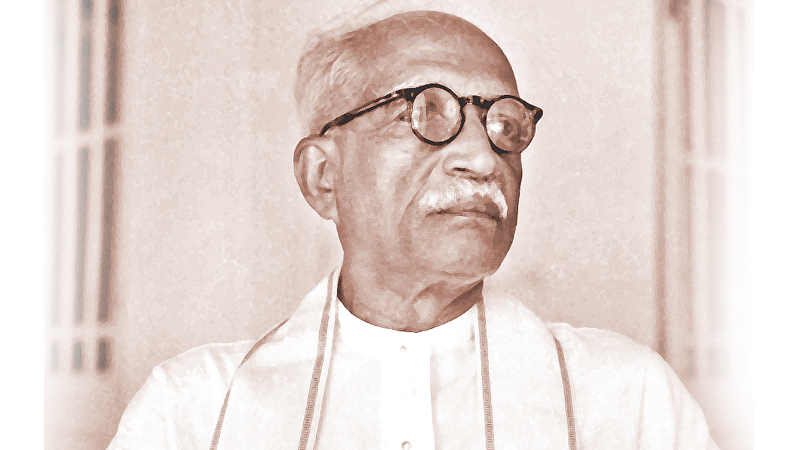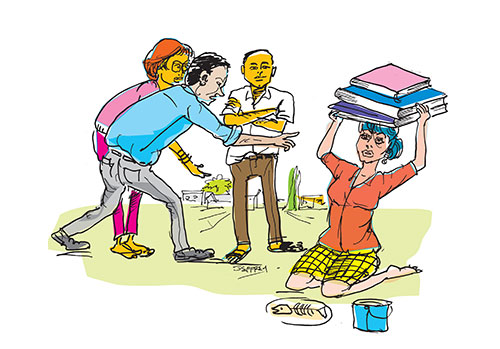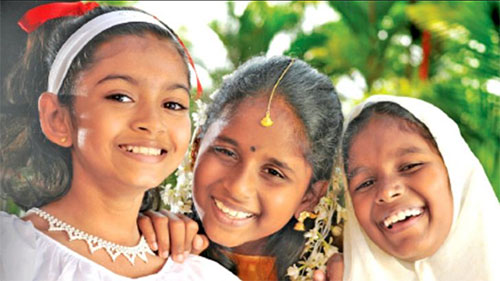By Nicola Perera
We, the citizens, were erased from the Independence Day ceremony, presided over by the supreme civil and military leadership of the state, at Galle Face. This was a far cry from last year, when this same space became the site of mass protests, as a collective expression of our agency, solidarity, and anger. Thousands of people, from diverse socioeconomic backgrounds, ethnicities, religions, gender and sexual identities, stood shoulder-to-shoulder, protesting against the gross economic mismanagement that had caused widespread suffering. In that larger movement of the poraṭṭam-aragalaya-struggle, the Inter-University Student Front (IUSF) played a major role by bringing its network and organisational weight to bear in months of dogged campaigning, countrywide, dialoguing with trade unions, and getting people out on the streets. It was student-protestors on the front lines against the violence unleashed in response by the state: their bodies confronted the teargas and batons, actively compelled the protests forward, every inch by literal, metaphorical inch. The state’s fear and loathing of these students is demonstrated in IUSF Convenor Wasantha Mudalige’s chilling account of how a police official had threatened his life while he was in detention, by laying a gun on the table between them and asking, “Do you remember what happened to Wijeweera?”
State propaganda, middlebrow sensibilities, and neoliberal subjectivity have all contributed to the long-standing depiction of student unions—with “IUSF” standing in metonymically for the concept of all politically active student unions, regardless of whether the actual IUSF is literally involved or not—as a social problem rather than a solution. The rhetorical claims made by supporters, and spokespeople of the state, range from the legitimate to the extreme: student unions are rightfully criticized for the rag as a means of recruitment, but public discourse often ranges much further, such as when a former minister described universities in militaristic terms as “uncleared areas,” implicitly calling for their violent suppression. As my colleague, Anushka Kahandagama, wrote recently in this column, the state fears the collectives of young citizens in the university. As seen in other countries, too, universities are often the birthplace of radical politics when intellectual awakening meets a passionate desire for social justice to challenge the political order.
It is within such an agenda of social justice that student unions have continued to uphold the cause of free education. In the years since its “6% of the GDP for education” campaign of 2012, free education has slipped down FUTA’s (Federation of University Teachers Associations) list of priorities in favour of car permits and jostling for positions in prestigious schools for their offspring. There is a growing opinion among staff (with flourishing, well-remunerated careers nurtured within the system) that the setting up of more private universities is the way forward for higher education in Sri Lanka. Therefore, it is to the credit of the IUSF and student unions, in general, to have not lost sight of the fact that free education is critical to the vast majority of students. It is their rights student unions represent and protect – marginalised students for whom education is not something they obtain by exercising their rights as elite consumers in the growing marketplace of private higher education institutions, but a means to escape from poverty for themselves and their families.
Amidst the many absurd and extreme claims made about the IUSF and student unions, however, there are genuine criticisms that affect their legitimacy: the violence student unions perform on their own in the form of the rag, and their own internal political conservatism. These failures and hypocrisies weaken the unions’ position and provide ammunition to their critics, and the state, that wishes to suppress them altogether. The unions’ loss of credibility here is the state’s gain, as it capitalises on the rhetorical power of these visible failures to dismiss all legitimate demands and criticisms of state policy and practice presented or supported by student protestors.
How do student unions reconcile activism to protect the democratic character of education with their endorsement of and complicity in the rag? Whether individual student unions are linked to the IUSF or other political configurations, their approach to student politics replicates a hegemonic control similar to the one they confront in the streets. Violence is inherent in this domination over the student body, sometimes just below the surface but often openly. In the last few months alone, at Peradeniya University’s Arts Faculty, students assaulted other students identified as anti-rag to prevent the latter from accessing the cafeteria. Also at Peradeniya, a mob of students attacked a member of the staff, and his son, in an altercation over the latter’s car damaging some student vehicles. This shameful history of violence breaks out into the public spotlight in incidents like the above or when a student is horrifically tortured to death, underlining the normative initiation of freshers into student culture through varying degrees of verbal, physical, and sexual harassment. This culture doesn’t merely impose a rigid hierarchy among students but reproduces a deeply patriarchal, homophobic politics and an unflagging Sinhala-Buddhist chauvinism that confines student minorities to the periphery.
The rag serves a political purpose in effectively coercing a captive population of students into demonstrations and protests, including in the name of free education. But empowering students to act in their own, or the nation’s, interests is fundamentally incompatible with a regime of student politics based on coercive principles. This is why university student unions, including the IUSF, must confront the contradictions in how they operate within the university space. Our students realise true agency through a process of individual and collective conscientisation that leads them to challenge the systems of oppression and injustice in the university and society. The unions contain the potential for this purpose, but to truly realise it, they must begin to criticise themselves as ruthlessly and rigorously as they criticise the state.



